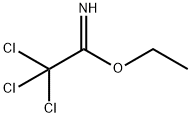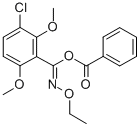ETHYL FORMIMIDATE HYDROCHLORIDE
Synonym(s):Ethyl methanimidate hydrochloride
- CAS NO.:16694-46-5
- Empirical Formula: C3H8ClNO
- Molecular Weight: 109.55
- MDL number: MFCD00192154
- SAFETY DATA SHEET (SDS)
- Update Date: 2022-11-11 11:01:00

What is ETHYL FORMIMIDATE HYDROCHLORIDE?
The Uses of ETHYL FORMIMIDATE HYDROCHLORIDE
Ethyl Formimidate Hydrochloride, is a building block used in various chemical synthesis. It can be used in the preparation of s-triazines, 2,3:5,6-di-O-isopropylidene-α- and -β-5-amino-4-ethoxycarbonyl or -carbamoyl-imidazole D-mannofuranosides. It can also be used as an reactant in the synthesis Bredinin via amination of an acyclic precursor, and Amidine conjugates of the ornithine moiety of an antifungal having therapeutic properties.
The Uses of ETHYL FORMIMIDATE HYDROCHLORIDE
Reactant involved in the synthesis of biologically active molecules including:
- Bredinin via amination of an acyclic precursor
- Amidine conjugates of the ornithine moiety of an antifungal
Reactant involved in:
- Intermolecular cyclization
- Mo-catalyzed asymmetric ring-closing metathesis for synthesis of cyclid amides and amines
- Synthesis of peptidic 1-cyanopyrrolidines
General Description
Ethyl formimidate hydrochloride is a nitrogen containing organic building block. On heating it undergoes degradation to afford formamidine hydrochloride, ethyl formate and ethyl chloride.
Properties of ETHYL FORMIMIDATE HYDROCHLORIDE
| Melting point: | 75 °C (dec.)(lit.) |
| Density | 0.78512 g/cm3(Temp: 25 °C) |
| storage temp. | 2-8°C |
Safety information for ETHYL FORMIMIDATE HYDROCHLORIDE
| Signal word | Warning |
| Pictogram(s) |
 Exclamation Mark Irritant GHS07 |
| GHS Hazard Statements |
H315:Skin corrosion/irritation H319:Serious eye damage/eye irritation H335:Specific target organ toxicity, single exposure;Respiratory tract irritation |
| Precautionary Statement Codes |
P261:Avoid breathing dust/fume/gas/mist/vapours/spray. P264:Wash hands thoroughly after handling. P264:Wash skin thouroughly after handling. P271:Use only outdoors or in a well-ventilated area. P280:Wear protective gloves/protective clothing/eye protection/face protection. P302+P352:IF ON SKIN: wash with plenty of soap and water. P305+P351+P338:IF IN EYES: Rinse cautiously with water for several minutes. Remove contact lenses, if present and easy to do. Continuerinsing. |
Computed Descriptors for ETHYL FORMIMIDATE HYDROCHLORIDE
New Products
4-Fluorophenylacetic acid 4-Methylphenylacetic acid N-Boc-D-alaninol N-BOC-D/L-ALANINOL Tert-butyl bis(2-chloroethyl)carbamate 3-Morpholino-1-(4-nitrophenyl)-5,6-dihydropyridin- 2(1H)-one Furan-2,5-Dicarboxylic Acid Tropic acid S-2-CHLORO PROPIONIC ACID ETHYL ISOCYANOACETATE 2-Bromo-1,3-Bis(Dimethylamino)Trimethinium Hexafluorophosphate (6-METHYL-[1,3]DITHIOLO[4,5-b]QUINOXALIN-2-ONE INDAZOLE-3-CARBOXYLIC ACID 4-IODO BENZOIC ACID (2-Hydroxyphenyl)acetonitrile 4-Bromopyrazole 5,6-Dimethoxyindanone 2-(Cyanocyclohexyl)acetic acid 4-methoxy-3,5-dinitropyridine 2-aminopropyl benzoate hydrochloride 1-(4-(aminomethyl)benzyl)urea hydrochloride diethyl 2-(2-((tertbutoxycarbonyl)amino) ethyl)malonate tert-butyl 4- (ureidomethyl)benzylcarbamate Ethyl-2-chloro((4-methoxyphenyl)hydrazono)acetateRelated products of tetrahydrofuran








You may like
-
 Ethyl formimidate hydrochloride 95.00% CAS 16694-46-5View Details
Ethyl formimidate hydrochloride 95.00% CAS 16694-46-5View Details
16694-46-5 -
 Ethyl formimidate hydrochloride CAS 16694-46-5View Details
Ethyl formimidate hydrochloride CAS 16694-46-5View Details
16694-46-5 -
 1975-50-4 98%View Details
1975-50-4 98%View Details
1975-50-4 -
 2-HYDROXY BENZYL ALCOHOL 98%View Details
2-HYDROXY BENZYL ALCOHOL 98%View Details
90-01-7 -
 2-Chloro-1,3-Bis(Dimethylamino)Trimethinium Hexafluorophosphate 221615-75-4 98%View Details
2-Chloro-1,3-Bis(Dimethylamino)Trimethinium Hexafluorophosphate 221615-75-4 98%View Details
221615-75-4 -
 61397-56-6 CIS BROMO BENZOATE 98%View Details
61397-56-6 CIS BROMO BENZOATE 98%View Details
61397-56-6 -
 14714-50-2 (2-Hydroxyphenyl)acetonitrile 98+View Details
14714-50-2 (2-Hydroxyphenyl)acetonitrile 98+View Details
14714-50-2 -
 118753-70-1 98+View Details
118753-70-1 98+View Details
118753-70-1
Statement: All products displayed on this website are only used for non medical purposes such as industrial applications or scientific research, and cannot be used for clinical diagnosis or treatment of humans or animals. They are not medicinal or edible.